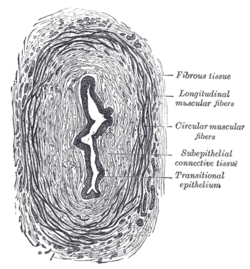Muscular layer
The muscular layer (muscular coat, muscular fibers, muscularis propria, muscularis externa) is a region of muscle in many organs in the vertebrate body, adjacent to the submucosa. It is responsible for gut movement such as peristalsis. The Latin, tunica muscularis, may also be used.
| Muscular layer | |
|---|---|
 | |
| Details | |
| Identifiers | |
| Latin | tunica muscularis |
| TA | A05.4.01.010 A05.5.01.021 A05.6.01.004 A05.7.01.004 A05.7.03.011 A05.7.04.009 A05.8.02.008 A08.1.05.010 A08.2.01.006 A08.3.01.010 A09.1.02.012 A09.1.04.010 A09.2.03.007 A09.3.05.009 A09.4.02.011 A09.3.06.003 A09.4.02.018 A09.4.02.027 |
| Anatomical terminology | |
 |
| This article is one of a series on the |
| Gastrointestinal wall |
|---|
|
General structure |
|
Specific
|
|
Organs |
Structure
It usually has two layers of smooth muscle:
- inner and "circular"
- outer and "longitudinal"
However, there are some exceptions to this pattern.
- In the stomach there are three layers to the muscular layer.
- In the upper esophagus, part of the externa is skeletal muscle, rather than smooth muscle.
- In the vas deferens of the spermatic cord, there are three layers: inner longitudinal, middle circular, and outer longitudinal.
- In the ureter the smooth muscle orientation is opposite that of the GI tract. There is an inner longitudinal and an outer circular layer.
The inner layer of the muscularis externa forms a sphincter at two locations of the gastrointestinal tract:
- in the pylorus of the stomach, it forms the pyloric sphincter
- in the anal canal, it forms the internal anal sphincter
References
This article incorporates text in the public domain from the 20th edition of Gray's Anatomy (1918)
External links
- Muscularis externa of the colon - BioWeb at University of Wisconsin System
- Smooth muscle layers of the gut - BioWeb at University of Wisconsin System
- UIUC Histology Subject 23
- Histology image: 11601ooa – Histology Learning System at Boston University — "Muscle Tissue: smooth muscle, muscularis externa"
This article is issued from Wikipedia. The text is licensed under Creative Commons - Attribution - Sharealike. Additional terms may apply for the media files.